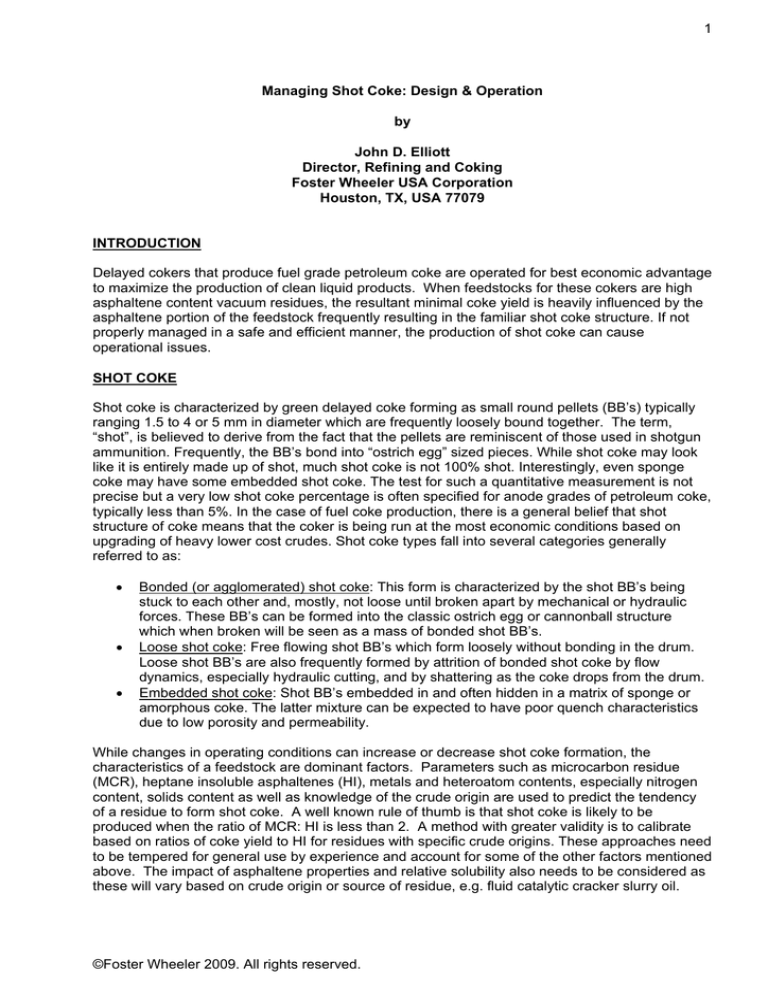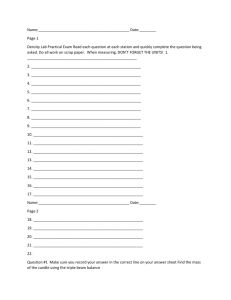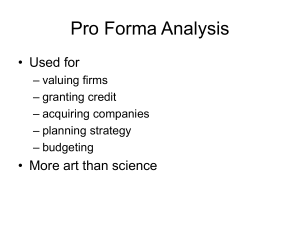
1
Managing Shot Coke: Design & Operation
by
John D. Elliott
Director, Refining and Coking
Foster Wheeler USA Corporation
Houston, TX, USA 77079
INTRODUCTION
Delayed cokers that produce fuel grade petroleum coke are operated for best economic advantage
to maximize the production of clean liquid products. When feedstocks for these cokers are high
asphaltene content vacuum residues, the resultant minimal coke yield is heavily influenced by the
asphaltene portion of the feedstock frequently resulting in the familiar shot coke structure. If not
properly managed in a safe and efficient manner, the production of shot coke can cause
operational issues.
SHOT COKE
Shot coke is characterized by green delayed coke forming as small round pellets (BB’s) typically
ranging 1.5 to 4 or 5 mm in diameter which are frequently loosely bound together. The term,
“shot”, is believed to derive from the fact that the pellets are reminiscent of those used in shotgun
ammunition. Frequently, the BB’s bond into “ostrich egg” sized pieces. While shot coke may look
like it is entirely made up of shot, much shot coke is not 100% shot. Interestingly, even sponge
coke may have some embedded shot coke. The test for such a quantitative measurement is not
precise but a very low shot coke percentage is often specified for anode grades of petroleum coke,
typically less than 5%. In the case of fuel coke production, there is a general belief that shot
structure of coke means that the coker is being run at the most economic conditions based on
upgrading of heavy lower cost crudes. Shot coke types fall into several categories generally
referred to as:
•
•
•
Bonded (or agglomerated) shot coke: This form is characterized by the shot BB’s being
stuck to each other and, mostly, not loose until broken apart by mechanical or hydraulic
forces. These BB’s can be formed into the classic ostrich egg or cannonball structure
which when broken will be seen as a mass of bonded shot BB’s.
Loose shot coke: Free flowing shot BB’s which form loosely without bonding in the drum.
Loose shot BB’s are also frequently formed by attrition of bonded shot coke by flow
dynamics, especially hydraulic cutting, and by shattering as the coke drops from the drum.
Embedded shot coke: Shot BB’s embedded in and often hidden in a matrix of sponge or
amorphous coke. The latter mixture can be expected to have poor quench characteristics
due to low porosity and permeability.
While changes in operating conditions can increase or decrease shot coke formation, the
characteristics of a feedstock are dominant factors. Parameters such as microcarbon residue
(MCR), heptane insoluble asphaltenes (HI), metals and heteroatom contents, especially nitrogen
content, solids content as well as knowledge of the crude origin are used to predict the tendency
of a residue to form shot coke. A well known rule of thumb is that shot coke is likely to be
produced when the ratio of MCR: HI is less than 2. A method with greater validity is to calibrate
based on ratios of coke yield to HI for residues with specific crude origins. These approaches need
to be tempered for general use by experience and account for some of the other factors mentioned
above. The impact of asphaltene properties and relative solubility also needs to be considered as
these will vary based on crude origin or source of residue, e.g. fluid catalytic cracker slurry oil.
©Foster Wheeler 2009. All rights reserved.
2
Interactions leading to the formation of the shot coke structure are:
As the feed is heated, vaporization occurs and cracking reactions begin. The
reactions taking place in the liquid phase may lead to the precipitation of the
asphaltenic components which will continue to react to form pre-coke and
eventually, coke. The pre-coke material is a high viscosity material having high
plasticity. The two-phase flow and the resultant velocity in the fired heater transfer
line and in the coke drum, combined with the surface tension of the pre-coke
material, act to shape this material into small spherical “beebees” or BB’s,
characteristic of shot coke. Liquid agitation and back mixing in the coke drum
further cause formation of ovoid to spherical shaped “eggs”.
SHOT COKE ISSUES
Shot coke can disrupt coke drum operations because it has a high bed density; it is frequently
loosely bound; and quenching is a non-ideal cooling operation. Specific operational issues that
can occur from time to time, depending on coker design and operations include:
•
•
•
•
Unquenched hot spots in the coke bed. This issue is not limited to shot coke production but is
often seen as more prevalent in shot cokers.
Blowbacks and eruptions of steam and coke resulting from water impacting unquenched hot
spots.
Plugging of the bottom nozzle of the coke drum during drum drains.
Coke beds dumps that trap drillstems during cutting or overwhelm the coke handling
equipment and require costly cleanups.
Short coking/ decoking cycle operations can increase the following problems associated with shot
coke due to faster quenching, draining and irregular cycles respectively:
•
•
•
Increased frequency of hot spots occurring following coke drum quench.
Increased frequency of incomplete drum drains.
Misoperation due to the pressure to stay on cycle time.
One additional issue: when operating at high temperatures for maximum liquid yield operations, it
is possible to produce shot coke that is low in volatiles and very hard, i.e. it will have low
Hardgrove grindablity index (HGI), which can be difficult to market.
MINIMIZING SHOT COKE PRODUCTION
Refiners with older cokers that have not instituted operational measures and/or modified their
coker to deal with shot coke might be reluctant to handle shot coke when processing heavy
crudes. This avoidance of shot coke production requires that they use a number of measures to
ensure that the coke produced is low in the percentage of shot coke it contains by employing
methods such as feed blending with lighter feed stocks that do not produce shot coke or operating
the coker at conditions where the coke production is not minimized and the yield of clean liquid
products is not maximized.
Shot coke formation can be suppressed by increasing the delayed coker pressure and/or the
recycle. Higher pressure will inhibit hydrocarbon vaporization, resulting in a dilution of the reacting
asphaltenes in the liquid phase and a reduction in the concentration of these species and the
overall reaction rate. Higher recycle will achieve a similar effect. Also, the reduction in
vaporization associated with the higher pressure will result in an overall reduction in the velocity of
the reacting mass in the fired heater. When using higher pressure operations, higher reaction
temperatures may be required to maintain appropriate coke properties.
The addition of fluid catalytic cracker (FCC) slurry oil into the coker feed will help to inhibit shot
coke formation because of the solubilizing effect of the aromatic slurry oil on the asphaltenes. If
©Foster Wheeler 2009. All rights reserved.
3
too a high percentage (typically above 10 to 15 percent on total feed) of slurry oil is blended into
the vacuum residue, a recycle of slurry oil can build up between the coker and the fluid catalytic
cracking unit. Use of slurry oil may also limit the amount of fresh vacuum residue feed that can be
processed.
Higher temperatures will tend to promote shot coke formation. Lower temperatures may therefore
be considered desirable. However, the temperature must not be so low that the reaction does not
proceed to coke.
Delayed cokers generally operate to a refiner’s best economic advantage when processing
vacuum residue from lower cost heavy crudes. Manipulation of coker operations to avoid shot
coke production is typically not economically advantageous for the refiner because of the resultant
loss of liquid yield and coker throughput.
SHOT COKE DESIGN DETAILS & OPERATIONS
Foster Wheeler normally suggests a 3 prong approach for dealing with shot coke involving:
1. Coker design,
2. Operating technique,
3. Operating instruction.
Most of these recommendations can be considered good practice regardless of the type of coke
produced in the delayed coker.
Design Details
A number of design details can be effective in dealing with shot coke production. These revolve
around providing safe and effective operations on the operating decks of the coke drum structure
and in the control room.
Top (Cutting) Deck: This is the top operating level of the coke drum structure. It is the location
for unheading the top flanged opening of the coke drum and the station for the operator cutting the
coke using the high pressure jet pump coke cutting system. Design details for this operating level
should include:
•
Enclosed operator shelter provided with ventilation, personnel protection, and line-ofsight to coke drum top head and the coke chute exit. Advanced designs that provide a
station for remote operations for top and bottom unheading devices as well as remote
coke cutting are now being employed. These remote operations are monitored via
video.
•
Multiple paths for emergency egress from the structure. Egress paths from all levels of
the coke drum structure should be protected. New designs employ fire barriers and
may additionally include water spray systems.
•
Teflon®-lined drill stem guide mounted on cross head rails to eliminate the need to have
personnel at open top manway to guide the drill stem into or out of the manway guide
plate.
•
Cutting system: Complete interlocked safety system (see below).
•
Advanced design unheading device for remote opening of top head. Top head
enclosures for cutting tools are now being marketed that may offer benefits to contain
and divert hot spot blowouts especially when using automated switch cutting tools.
•
An additional coke drum level detector near the top, which can be used to confirm that
the coke bed is sufficiently submerged below the quench water level.
©Foster Wheeler 2009. All rights reserved.
4
Bottom (Unheading/Switch) Deck: This is the lower operating level in the structure where
operations for switching coke drums, unheading the bottom flange, and lining up auxiliary systems
for steaming, quench drain, etc. take place. Design details for this operating level should include:
Slide valve unheading-reheading devices with remote operator stations to
avoid operator exposure to coke and hot steam discharges which can be a
hazard otherwise. Appropriate installation of the bottom unheading slide
valve system includes a fixed chute for carrying the cut coke out of the drum
to the recovery system. The fixed chute has the benefit of containing and
diverting shot coke fallouts from the drum. The use of slide valve bottom
unheading is the single most important improvement in safe cutting and
handling of shot coke around the coke drum.
Remote location for operator station for bottom unheading. Monitoring is via
a dual camera system.
The bottom inlet line of the coke drum should be provided with the capability
for a high rate of sweep steam.
While there are design details for improving shot operations if a slide valve device is not used,
they are not recommended over the use of slide valves. Some of these details are:
Use of remote operated advanced hydraulically operated unheading devices
that constitute an improvement over old cart unheading systems. This
should include remote hydraulic operation for the coke chute.
The coke drum bottom inlet should be provided with a device that minimizes
the likelihood of loose shot coke BB’s or “eggs” plugging the nozzle. A
raised vortex breaker or distributor is effective.
For bolted bottom head manual operations use of a sufficient number of
“long bolts” to prevent head collapse when the partially lowering the bottom
head if a hydraulic unheader is not used.
Consider a barrier between the bottom unheading control station and
unheading device to provide a physical isolation for the operator.
Use automated graylock fitting for inlet connections.
Interlocks: The following interlocks should be included for prudent design regardless of type of
coke being produced:
1. Permissive interlock of Switch Valve, Inlet Isolation Valves (SP-6’s) and Utility Isolation
Valves (SP-7’s): This is a permissive system that performs the following functions:
•
Prevents a switch valve from being switched into a closed inlet isolation valve thereby
dead-ending the heater.
•
Prevents the Utility Isolation Valves (SP-7) from being opened if the respective Inlet
Isolation Valve is open. This prevents transfer line hot oil from being inadvertently
directed to the drain line.
•
Requires that the Utility Isolation Valve (SP-7) be closed before the switch valve can be
switched to its respective drum.
•
Prevents the Inlet Isolation Valve from being closed if the switch valve is positioned to
feed into it.
2. Permissive Interlock of Coke Drum Overhead Relief and Vent: A motorized block valve is
located on the discharge of the coke drum relief PSV’s. This is especially important when
there are multiple drum pairs to prevent backflow of blowdown vapors to an open coke
©Foster Wheeler 2009. All rights reserved.
5
drum. This valve is interlocked to prevent its inadvertent closure unless the respective
coke drum vent and / or top head are open. The interlock alarms if the PSV discharge
valve is not closed immediately after opening the vent valve.
3. Permissive interlock to the hydraulic power unit for the unheading system signaling that it is
OK to unhead the drum. Without the permissive signal, the unheading system cannot be
powered up preventing accidental coke drum unheading. The permissive signal is
generated by a logic controller which in turn requires multiple positive signals that allows it
to ensure that there is a correct and safe alignment of the coke drum isolation and vent
valves.
4. The bottom head is prevented from opening unless the top head is confirmed open.
The top head is prevented from closing unless the bottom head is confirmed closed.
5. The coke drum overhead isolation valves (SP-1 & SP-2) are prevented from closing if
the main feed valve (SP-6) is open, and the main feed valve (SP-6) is prevented from
opening if the overhead valves (SP-1 & SP-2) are closed.
6. Interlock of the coke drum outlet isolation valves and the valves to the blowdown system to
manage mis-alignment.
7. Heater pass flow, fuel pressure and combustion air interlocks.
8. Coke cutting system valving, drill stem insertion, rotating equipment operators and jet
pump operation interlocks.
Total automation features: Many refiners want maximum automation of the coker structure
operations with the goal of minimizing operator attendance and eventually eliminating the
scheduled need to have operators in the structure. The systems and designs required to
accomplish this are extensive and include motor operators on many valves that were previously
operated manually; top and bottom slide valve devices; and an auto-shift cutting tool. The goal is
to require that complete coke drum operations over the entire cycle including coke cutting and
valve switching be performed from a remote location off the structure rather than being handled by
an operator located on the coke structure.
Operational Techniques
Operational techniques include improved coke drum quench and dynamic manipulation of the
operation to (1) minimize the occurrence of hot spots and (2) premature bed dumps for non-slide
valve operations by modifying the coke structure in the bottom of the drum.
a. Coke drum quench to minimize hot spots:
•
•
•
•
•
Completely fill with water to a provided additional nuclear level detector level
located above the top of the coke bed. Since most hot spots occur near the
top of the coke bed it is important to make sure the top of the bed is well
quenched.
Slow, optimized quench ramping the rate based on experience minimizing
hot spots.
Optional techniques: ½ to 1 hr soak time or, in extreme situations, use of an
overflow operation.
Track quench and blowdown system water flows to verify that the coke drum
is flooded with water.
Maintain a pressure on the coke drum during quenching to improve water
contact with hot coke. `
b. Dynamic Manipulation of Operation
©Foster Wheeler 2009. All rights reserved.
6
•
Raising heater outlet temperature for the last 2 to 4 hours of the coking
cycle produces lower VCM coke in the bed top, which is harder, easier to
quench, and less prone to create hot spots. Optionally, use lower
temperature following switch and ramp the heater outlet temperature over
the coking cycle to a high weighted average temperature.
•
Switch Techniques: Always maintain a forward flow of fluid to minimize
likelihood of uncoked tars in drum from back-flowing in the drum coke bed
and plugging coke structure pores prior to cooling water access; steam must
be introduced prior to switch.
If a bottom slide valve unheading device has not yet been retrofitted, the following can be
considered to minimize fallout problems when producing shot coke:
•
Use lower temperature following switch to modify the coke structure
formation in the bottom of the coke drum to denser coke, which is less likely
to experience dumps and better able to contain minor blowouts due to hot
spots. The heater outlet temperature is ramped up following the initial
period.
•
Optional use of FCC slurry oil diluent to solubilize feed asphaltenes to coke.
The asphaltenes producing shot coke can be solubilized with decant oil
changing the coke structure to a less loose coke matrix. If the decant oil is
charged for 1 or 2 hours following the switch into a drum, the coke in the
drum bottom can act as a significant plug to contain flow-outs of loose shot
coke. This can be especially effective when combined with the temperature
heater ramp techniques described above. However the use of slurry oil in
this manner may back feed out of a coker operating at full capacity and may
therefore not be considered economic.
Operating Instructions
The following safety measures are among those that should be adhered to during unheading and
cutting operations. These are considered good practice in all coker operations.
•
Audible alarms on decks and at grade at the start of unheading, light alarms
/ warning beacons until cutting / reheading complete.
•
Do not unhead the coke drum top until the drum is vented and then drained.
This is necessary to prevent boil-overs of scalding water and steam in the
event of poor drum quenching due to hot spot operations.
•
All non-essential personnel to be off drum structure, or at safe locations,
during the unheading and cutting operation.
•
Prior to and during draining, unheading and cutting, operators must be alert
for telltales of possible hot spots, such as high “banana” leaning of the drum,
rumbling sounds and differential skin temperatures, and take timely action
accordingly.
•
Cutting operators to remain in their shelter any time the cutting system is
pressurized and cutting is underway.
•
Ensure sufficient positive forward flow of steam and/or water as feed is
switched out of the drum to keep the inlet line from plugging. When blowing
the transfer line clean with steam, observe normal safety precautions for
©Foster Wheeler 2009. All rights reserved.
7
personnel safety.
•
Cutting operators to verify that operators of any crane, front-end loaders,
etc. have been notified that coke will be issuing from the coke chute.
For conventional and non-slide valve unheading systems:
• Unheading personnel to remain at the remote location after bottom unheading, until cutting
has been completed.
• Access for head cleaning, reheading, drum preparation, etc., should be available only after
completion of cutting.
• Proper use of Personnel Protective Equipment (PPE) to be used at all times during the
head removal.
Conclusions:
Coker operations can produce shot coke when heavy feedstocks are processed for maximum
liquid yield. Manipulation of operating conditions to minimize or avoid shot coke production is
generally not economically advantageous. Fortunately the operational issues caused by shot coke
production can be addressed by application of design details, operational techniques and
operating instructions such as those given above.
©Foster Wheeler 2009. All rights reserved.
8
Shot Coke (Partially crushed to show shot structure)
Sponge Coke
©Foster Wheeler 2009. All rights reserved.
9
Coke Drum Valve Interlocks
Coke Drum Bottom Slide Valve Unheading System
©Foster Wheeler 2009. All rights reserved.
10
Closed Slide Valve Unheading System
Courtesy of DeltaValve
Top (Cutting) Deck
Bottom (Unheading /
Switch) Deck
Coke Drum Structure
©Foster Wheeler 2009. All rights reserved.
11
Shot Coke Cannonballs on Coke Drum Bottom Head
(Non-slide Valve Unheading)
Shot Coke in Coke Pit after Chute Discharge
©Foster Wheeler 2009. All rights reserved.



